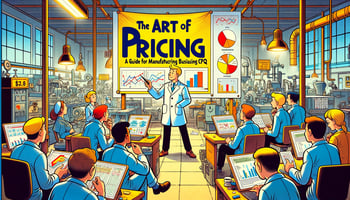Is your pricing strategy aligned with what your customers value most? In today's competitive...
Price Waterfall + CPQ: The Combination for Smarter Pricing Over Time
When companies launch a CPQ system, they often realize something uncomfortable: they know their list prices, but they don’t actually know their real net prices. What happens between the list price and the money that ends up in their accounts is often a mystery — hidden discounts, late-stage rebates, ad-hoc exceptions, or freight costs that no one really tracks.
That’s where the Price Waterfall comes in — and when you combine it with CPQ and Business Intelligence (BI), you unlock a smarter, more powerful approach to pricing improvement.
At cpq.se, we help manufacturers understand that they don’t need perfect pricing at the start. In fact, waiting for pricing perfection before implementing CPQ is often a strategic mistake. The real goal is to launch, gather data, and evolve pricing based on real-world behavior.
The Price Waterfall gives you the map.
CPQ gives you the engine.
BI gives you the fuel to move forward.
What is the Price Waterfall?
The Price Waterfall is a simple but powerful concept: it shows the step-by-step deductions from the original list price down to the final pocket margin you actually collect. Each step — special discounts, payment terms, freight charges, bonuses, rebates — eats into the revenue.
Without visibility into each of these steps, it’s easy for margins to evaporate unnoticed.
Mapping your Price Waterfall forces you to answer critical questions:
-
How much are we really discounting, across different channels and regions?
-
Which incentives are reducing margins without increasing volumes?
-
Are our rebate programs profitable or leaking value?
Most companies are shocked the first time they see their real Price Waterfall. It almost always highlights hidden leaks — places where value is being given away without clear commercial benefits.
Why CPQ is the Perfect Partner for the Price Waterfall
It’s one thing to draw a Price Waterfall diagram. It’s another to operationalize it inside your sales process. That’s where CPQ technology becomes essential.
Modern CPQ platforms like Tacton CPQ allow you to:
-
Structure your list prices clearly, even across complex, highly configurable products.
-
Apply discount rules systematically, so exceptions are visible and controlled.
-
Track surcharges, freight adjustments, and rebates automatically within the quote.
Instead of managing these steps manually, your CPQ system becomes the live execution engine for your Price Waterfall. Every quote your sales team sends builds your understanding of how your pricing actually works in the field.
At cpq.se, we help our customers align their CPQ pricing models with their real-world commercial practices. That way, the CPQ system becomes not just a quoting tool, but a data collection platform for smarter future decisions.
Business Intelligence: The Missing Link for Smarter Pricing
Collecting data is not enough. You have to analyze it — and act on it.
That’s why we integrate Business Intelligence (BI) tools into every CPQ project we deliver. BI enables you to slice and dice your CPQ data:
-
Analyze margin erosion at every step of the Price Waterfall.
-
Identify segments where price realization is weak.
-
Spot trends in discounting behavior across teams or regions.
-
Measure performance over time against targets.
Instead of arguing about pricing in management meetings, you can show real evidence: “This segment consistently achieves 5% better margin with lower discount levels.” That’s the power of BI.
Over time, your pricing model becomes smarter — based not on assumptions or traditions, but on facts.
Evolving Over Time: The cpq.se Way
At cpq.se, we believe in a practical approach:
-
Short-term: Get CPQ operational with a realistic, structured model that matches today’s reality.
-
Long-term: Improve pricing over time using CPQ-driven BI data, without disrupting day-to-day operations.
We help you build a Price Waterfall that reflects your actual business, not a theoretical ideal. Then, we help you monitor, adjust, and refine your pricing step-by-step.
Companies like HMF and Swift Lifts have benefited from this method — not by chasing pricing perfection at go-live, but by continuously improving once real transaction data started flowing through their CPQ systems.
Why Waiting is a Strategic Mistake
It’s tempting to think that you should fix your pricing first and launch CPQ later. But in practice, that’s a risky bet. Pricing complexity rarely gets simpler on its own. And the longer you delay, the longer you stay blind to the real drivers of your commercial performance.
By starting your CPQ project now, even with imperfect pricing, you gain visibility. You start gathering insights. You build a foundation for smarter decisions, better margin control, and stronger customer segmentation.
Perfect pricing isn’t the starting point.
It’s the result of a journey that starts with launching CPQ and learning every day.
👉 Further Reading: How to Succeed with Your CPQ Pricing Strategy
☕ Want to talk about how CPQ and Price Waterfall mapping can sharpen your margins?
Book a virtual coffee with Magnus Fasth or Patrik Skjelfoss: https://www.cpq.se/meetcpqse



